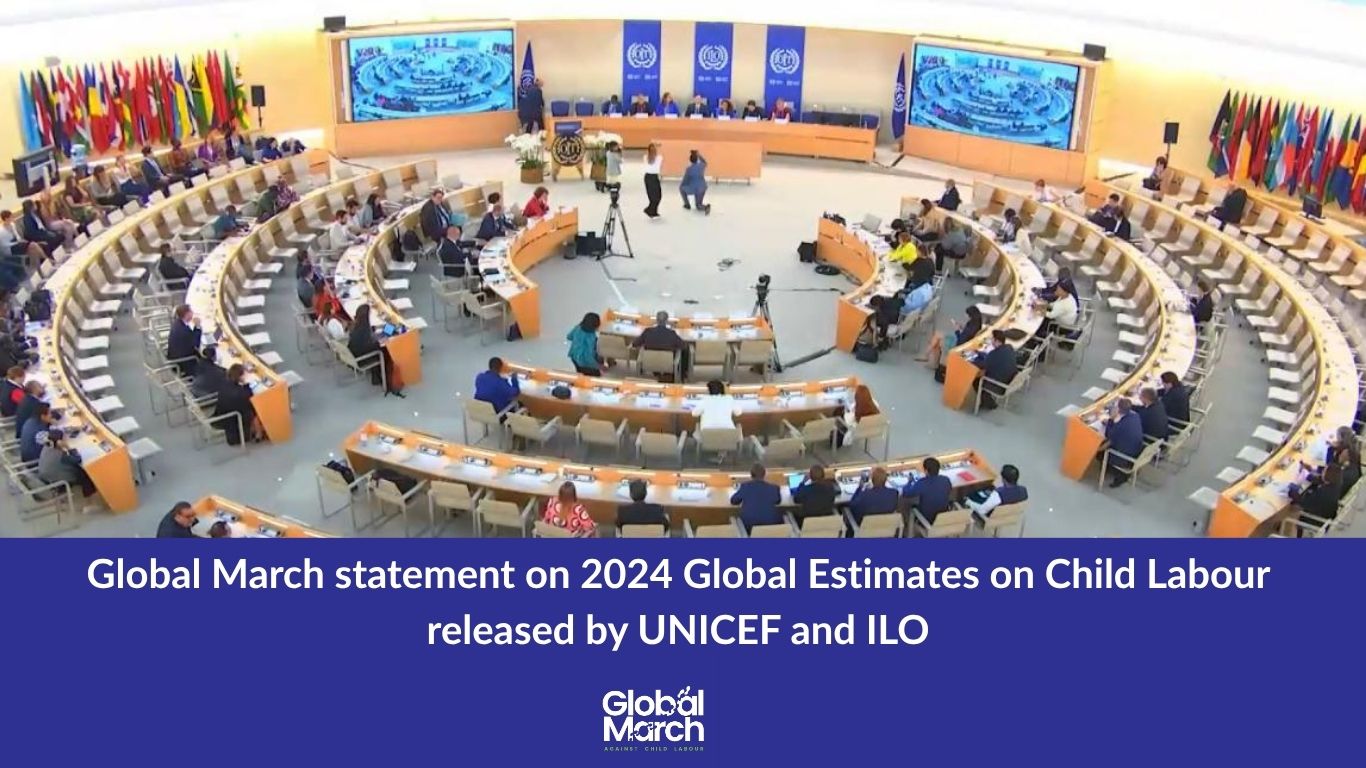Global March statement on 2024 Global Estimates on Child Labour released by UNICEF and ILO
Date: June 12, 2025
The Global March Against Child Labour welcomes the latest global estimates released by the International Labour Organization (ILO) and UNICEF. According to the report, the number of children in child labour has declined from 160 million in 2021 to approximately 138 million in 2024, including 54 million in hazardous work. Since 2000, over 100 million children have been removed from child labour. This progress proves that change is possible.
But the numbers also carry a warning: the root causes of child labour remain unaddressed, and in some cases, are worsening. Poverty, household income insecurity, inadequate social protection, gender inequality, school dropouts, and lack of access to education—especially migrants and marginalised communities continue to push children into work and out of school.
While the Asia-Pacific region saw a 43% reduction in child labour, the absolute number in Sub-Saharan Africa remains at 87 million, unchanged due to population growth and weakened social services. Agriculture continues to account for 61% of all child labour, followed by domestic work (27%) and industry (13%). Over a third of school-aged children in child labour are out of school—rising to nearly half among those in hazardous work.
Nearly one in five children globally—473 million—live in conflict zones, where access to education is disrupted or impossible. In Sudan, 17.4 million children are out of school due to war. In Gaza, 96% of school buildings have been damaged or destroyed, leaving 625,000 children without access to learning.

“These new figures show that past investments in prevention, education, and community-based action are paying off. But the numbers also remind us that we are far from done—especially in Sub-Saharan Africa, where child labour remains alarmingly high,” said Marco Dubbelt, Senior Director of Global March Against Child Labour. “To truly improve the lives of the hardest-to-reach children, we must invest in area-based approaches that lift entire communities out of poverty. That means linking child labour elimination with decent work for parents, access to income and credit, and universal social protection.”
Persistent and Evolving Challenges
Despite global efforts, access to education remains in crisis. UNESCO’s 2024 Global Education Monitoring Report finds that 251 million children and youth are still out of school globally—with little improvement in the past decade. Sub-Saharan Africa is home to more than half of these children, revealing stark inequalities.
In low-income countries, one in three school-aged children is out of school, compared to just 3% in high-income countries. This disparity drives child labour. The growing privatisation of education in the Global South has deepened these inequities, as public systems remain underfunded and inaccessible for many.
In countries like Uganda, child labour has surged from 14% in 2016/17 to 39.5% in 2021. In Nigeria, 35.3% of children aged 5–14 are juggling work and education—or working instead of attending school. These alarming figures highlight the failure of current approaches to protect vulnerable children.
Gaps in Decent Work and Family Livelihoods
Child labour cannot be ended in isolation from the working conditions and livelihoods of adults. Where decent work is unavailable, wages are exploitatively low, and jobs are informal or precarious; families are pushed to rely on their children’s labour survival
In many high-risk sectors like agriculture, informal services, and domestic work, adults face underpayment, lack of contracts, unsafe conditions, and no access to social security. This deepens household vulnerability and intergenerational poverty.

“The scandal of child labour is inseparable from the crisis of decent work,” said Luc Triangle, General Secretary of the International Trade Union Confederation (ITUC). “When wages are suppressed, jobs are informal, and workers are denied rights, it is their children who bear the cost—forced to leave school and work to make up the shortfall. There is no path to ending child labour that doesn’t begin with guaranteeing decent work for all, strengthening collective bargaining, and ensuring income security for working families.”
Triangle warned that the world is poised to miss Sustainable Development Goal Target 8.7—to end child labour by 2025—unless governments and employers make binding, enforceable commitments, not just voluntary pledges.
What Needs to Happen in the Next Five Years
At the 2025 International Labour Conference, governments, workers, and employers reaffirmed the urgent need to address the structural drivers of child labour. Delegates identified three core priorities:
- Promoting decent work for caregivers, particularly in informal and rural sectors, so families can depend on secure incomes rather than child labour.
- Increasing targeted investment in prevention, with clear commitments from governments to ringfence funding, and from businesses to go beyond risk mitigation and invest in long-term solutions.
- Guaranteeing universal access to social protection and free, quality education, with a focus on reaching children most at risk, especially girls, migrants, children with disabilities, and those affected by conflict or displacement.

“Child labour undermines the productivity of future work forces and holds back entire economies. We must not allow the childhood and rights of yet another generation to be lost.”- Manuela Tomei, ADG, ILO at ILC’25
Looking ahead to the 2026 Global Conference on Child Labour in Morocco, Global March Against Child Labour urges a shift from statements of intent to concrete, coordinated action.
Platforms like Alliance 8.7 remain central to this global effort. They provide space for governments, social partners, and civil society to align national priorities, share good practices, and report on progress. Pathfinder Countries have shown that political leadership, data-driven strategies, and collaboration can drive measurable impact. These efforts must now be strengthened and expanded.
Governments and employers must make binding, time-bound commitments to scale up social protection, enforce labour laws, and prioritise increased funding to address child labour in vulnerable communities. The private sector must integrate child labour prevention into core business operations—supporting community-based monitoring systems, improving conditions in supply chains, and aligning with international frameworks such as the ILO Conventions and the EU Corporate Sustainability Due Diligence Directive (CSDDD).
Finally, civil society organisations and trade unions play a critical role in delivering local solutions, strengthening accountability, and ensuring that the voices of affected communities are heard. Their leadership and collaboration must be recognised and supported across all levels of implementation.
The next phase must be judged by results—fewer children working, more children in school, and real accountability from those with the power to make change happen.

